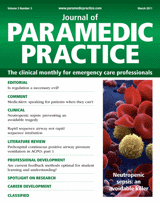Is less sometimes more? Airway management in cardiac arrest…
In this retrospective database analysis, McMullan and colleagues reviewed the Cardiac Arrest Registry to Enhance Survival (CARES) registry for 2011 to determine the influence of airway management approach on rates of sustained return of spontaneous circulation (ROSC), survival to hospital admission, survival to hospital discharge and survival to hospital discharge with good neurological outcome (Cerebral Performance Category 1 or 2).
The CARES registry collates data relating to cardiac arrest from 400 emergency medical service (EMS) agencies across the USA. This analysis included adults (age ≥18 years) and excluded cases where age was unknown or not reported and where airway management data were not reported or the device used was listed as ‘other’. Cases were classified as receiving endotracheal intubation (ETI), supragalottic airway (SGA) insertion or no advanced airway. SGA devices used by participating agencies include King Laryngeal Tube, Combitube and Laryngeal Mask Airway (LA). Cases where ETI or SGA insertion failed were classified as no advanced airway.
Outcome analyses compared ETI versus SGA, and no advanced airway management versus advanced airway management (SGA or ETI). During 2011 there were 12 875 cardiac arrests reported. Children (n=256), patients where age was unknown (n=83) and cases where the EMS agency did not provide airway management details (n=1,847) were excluded from analysis.
An advanced airway was placed in over 80% of the remaining 10 691 patients, with approximately two-thirds undergoing ETI. The King airway was the most commonly used device in the third of patients managed via SGA. Patients undergoing ETI were more likely to be male and older and less likely to receive public access defibrillation. Patients receiving no advanced airway were more likely to have a cardiac arrest in a public location or healthcare facility and to have their arrest witnessed by EMS staff and present with a shockable arrest rhythm.
ETI was independently associated with increased adjusted odds of sustained ROSC, survival to hospital admission, hospital survival and good neurological outcome when compared with SGA insertion. Stratification of outcomes according to presenting arrest rhythm revealed that these associations persisted for patients in shockable rhythms only. Patients with no advanced airway intervention demonstrated higher adjusted odds of survival when compared with those receiving ETI or SGA.
These results must be interpreted with caution given some of the methodological limitations associated with this study. The CARES registry does not provide data relating to number of attempts at advanced airway insertion; therefore, it is not clear in how many cases a SGA was inserted as a rescue device following ETI failures that might be expected to result in worse outcomes. Patients who did not receive advanced airway management may also represent a group in whom ROSC was achieved more rapidly, negating the need for such intervention and representing a group with potentially higher survivability. Similarly, in-hospital data relating to potential confounders such as use of mild therapeutic hypothermia and percutaneous coronary intervention are lacking. Nonetheless, these findings again challenge the assumption that SGA devices are a universal alternative to ETI in out-of-hospital cardiac arrest.
‘Witnessed resuscitation’: whose choice is it in emergency care settings?
Enabling lay people to be present during cardiopulmonary resuscitation (CPR) attempts has become known as ‘witnessed resuscitation’. There is a growing body of literature that indicates that the public want, at the very least, to be given this option, with some studies reporting that in cases of unsuccessful resuscitation being allowed to be present during the event facilitates an understanding of death and can help people with grieving processes.
Walker was concerned that little was known about emergency care staff's actual life-world experiences of performing this role in the presence of lay people.
Using an interpretative phenomenological approach, 20 semi-structured interviews (ambulance staff n=8; registered nurses n=12) were undertaken between June 2005 and June 2008. Ultimately, two of the interviews with nurses were excluded because information given was based on hypothetical scenarios rather than actual lived experience—although the author does not elaborate any further on this issue.
The inclusion criteria for the author's study were simply that participants had to have experience of performing CPR on adults (age ≥16 years) in the presence of a lay person; in the case of ambulance staff in a pre-hospital setting, and for registered nurses in a setting at the point of entry to secondary care, such as in an emergency department or medical assessment unit.
The interviews were transcribed verbatim and data were subjected to thematic analysis. Initially, 15 minor (collective) themes emerged, which were further analysed into five major (unifying) themes comprising: respect for lay persons; professional dominance; expressions of disquiet; preparation for lay presence; the perceived effects of exposure.
Interestingly, there were some differences between the professional groups, for example in the theme ‘respect for lay persons’ where ambulance staff identified examples of active lay participation in the resuscitation attempt, such as assisting with chest compressions or ventilation, whereas nurses reported a more passive, observation role except in the final stages before death where the lay person might be encouraged to talk to the patient, or hold their hand.

The theme of ‘professional dominance’ illustrates a variety of experiences which, perhaps unsurprisingly, often reflected the critical nature of the event where the healthcare professional prioritised the care of the patient in cardiac arrest rather than the needs of the lay person.
Within ‘expressions of disquiet’, there was recognition that ‘being watched’ could be considered as an added pressure, or sometimes ambulance staff identified that the presence of lay people could be a distraction, particularly if the lay person was emotional or, quite understandably, in need of support. Participants from both professional groups discussed that if it became clear that the patient was not going to survive then, even before the end of the resuscitation attempt, their thoughts would turn to how best to break the news to friends and family.
In relation to ‘preparation for lay presence’ both ambulance staff and nurses demonstrated consideration of a variety of factors. For ambulance staff, lay presence was seen as a usual event and continued presence of these individuals was based on, for example, assessment of scene safety, suitability of lay involvement in the resuscitation, consideration of what support could be offered to the lay person. For nurses, decisions to enable entry to the resuscitation room involved other considerations, such as gaining permission from the attending team, severity of the patient injury, emotional state of the lay person, available physical space, although, nurses identified that, on occasion, the lay person just arrived with the ambulance crew and subsequently remained with the patient.
Within ‘perceived effects of exposure’ it was clear that participants recognised the potential for both positive and negative effects on the lay person. Both ambulance staff and nurses alike acknowledged that a combination of practical experience and their own confidence in their clinical abilities and competence influenced how they coped with ‘witnessed resuscitation’; and several participants identified that lay presence was not viewed as detrimental to the resuscitation process.
Overall, the findings from this study appear to challenge some results from previous research, which report negative attitudes towards ‘witnessed resuscitation’ from emergency care staff. There were clear differences between working practices in relation to ‘witnessed resuscitation’ among both ambulance and hospital staff influenced by several factors including location and environment. In addition, Walker suggests there is an increased display of professional dominance in the in-hospital setting, whereas there is a tendency toward a more facilitatory approach by ambulance staff in pre-hospital settings.
Walker concludes by recommending increased interprofessional collaboration to support holistic emergency resuscitative care, and, in particular, she emphasises that consideration should be given to working with and learning from paramedics and emergency medical technicians, especially given their familiarity of performing CPR in the presence of lay people.

